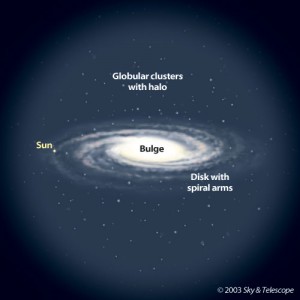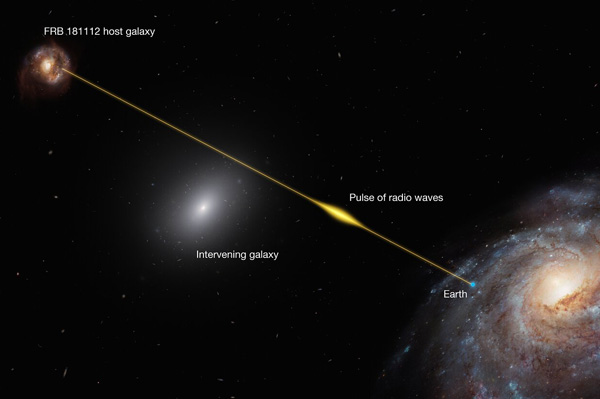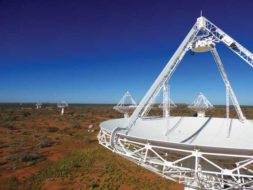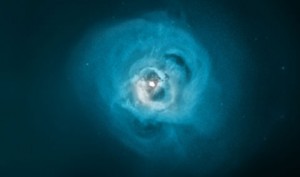Exotic Messenger Probes a Galaxy’s Outer Reaches – Sky & Telescope
Astronomers made use of a fast radio burst, a 40-microsecond flash at radio wavelengths, to evaluate the state of the nearly undetectable gas around an intervening galaxy.
There’s half of our galaxy that we barely know is there — a hot halo of gas that’s only just detectable. Now astronomers have found another way to study the nearly invisible.
Detecting the (Nearly) Undetectable

A giant halo surrounds our Milky Way Galaxy, seen here from a hypothetical outsider’s viewpoint.
Steven Simpson / S&T
The mass of the hot, gaseous halo that surrounds most massive galaxies, including the Milky Way, is on par with the mass of all the stars in the galaxy itself. In fact, the halo might hold the very gas that will form future stellar generations.
Yet it largely evades detection. A galaxy’s halo gas is extremely hot — “cooler” clouds of some 10,000 kelvin (17,500°F) float within a hotter, million-degree atmosphere. This atmosphere is also incredibly thin, with only a couple hundred atoms within the space of a child’s balloon. So typically, the only way to see all this gas is indirectly, by the way it absorbs the light of background sources such as quasars.
But quasars aren’t the only sources of radiation that can penetrate the cosmos. Like quasars, mysterious and ephemeral fast radio bursts can also travel billions of light-years, carrying the imprints of the cosmic expanse they traverse when they at last arrive at Earth.

Short bursts of radio waves from FRB 181112, each less than 40 microseconds long, passed through an intervening galaxy’s halo, probing its structure.
ESO / M. Kornmesser
Astronomers reported in the September 27th Science what happened when a 40-microsecond radio flash passed through the halo of an intervening galaxy. The results are surprising: The radio waves seem almost entirely undisturbed, indicating a calmer halo than astronomers would have thought.
One Mystery Probes Another
Fast radio bursts offer a new (albeit, still indirect) way to probe halos. Radio waves travel through the vacuum of space at the speed of light. But when they pass through gas, such as the hot gas in a galaxy’s halo, they slow down, and longer wavelengths slow down more than shorter wavelengths. The shorter wavelengths arrive at Earth first; the delay in the arrival of the longer wavelengths is known as the dispersion measure. Astronomers can use the dispersion measure to gauge how much gas the radio waves have passed through.
Xavier Prochaska (University of California) and colleagues probed the halo of a galaxy using the fast radio burst FRB 181112, detected using the Australian Square Kilometer Array Pathfinder (ASKAP). ASKAP immediately pinpointed the source to a specific location on the sky, and astronomers determined the galaxy most likely to host the source.
What the source is remains unclear. In one scenario, highly magnetized neutron stars generate radio-wave flashes, but the jury is still out on whether this scenario holds for fast radio bursts in general.

The ASKAP radio telescope in Western Australia has the ability to pinpoint the sources of ephemeral fast radio bursts.
CSIRO
Regardless what causes these bursts, the end result is that a powerful packet of radio waves has traversed billions of light-years on its way toward Earth. Along the way, according to the precise location mapped out by ASKAP, this packet passed within 95,000 light-years of a foreground galaxy. The intervening galaxy has old stars and a central, supermassive black hole that’s still munching on a midnight snack.
The FRB passed close enough to the galaxy to have passed through its halo, but whatever medium it passed through barely made a dent on the radio signal. If there is a halo around this galaxy, it’s calm and thin. Even the cooler clouds floating in the hotter plasma appear to be few and far between. In other words, the halo is surprisingly boring compared to the turbulent, magnetized plasma astronomers were expecting.
Keep Calm and Carry On

The black hole at the center of an elliptical galaxy in the nearby Perseus Cluster is pushing out cavities that appear like distorted bubbles in the surrounding X-ray-emitting gas. The black hole at the center of the intervening galaxy might have cleared similar cavities around its host.
NASA / CXC / SAO / E. Bulbul & others / XMM / ESA
It’s possible that the once-actively guzzling black hole at the center of this galaxy pushed out jets of material that evacuated the inner halo. It’s also possible that the gas that galaxies swim in is simply more serene than expected.
“Our research appears to reveal something entirely new about galactic halos,” Pocharsky says. “Unless, of course, this galaxy happens to be just some weird exception—and with only one object you can’t be sure about that.”
The team plans to follow up on other fast radio bursts to test this scenario in other galaxies. “I take this as a neat demonstration of what we’ll be able to do with a much larger sample,” says Vikram Ravi (Caltech), who was not involved in the study.
Ultimately, though, astronomers may have to turn to other wavelengths, such as X-rays, to directly detect and even map out galaxy halos.





